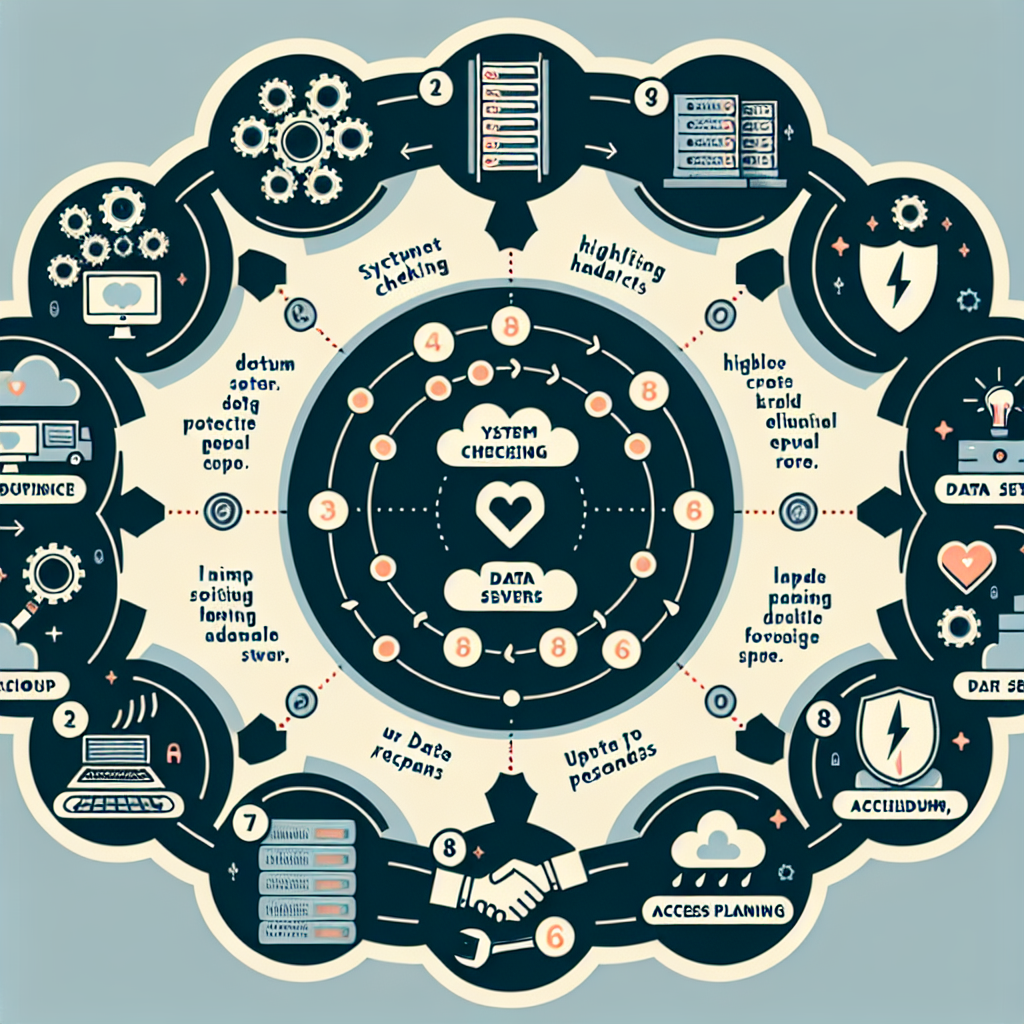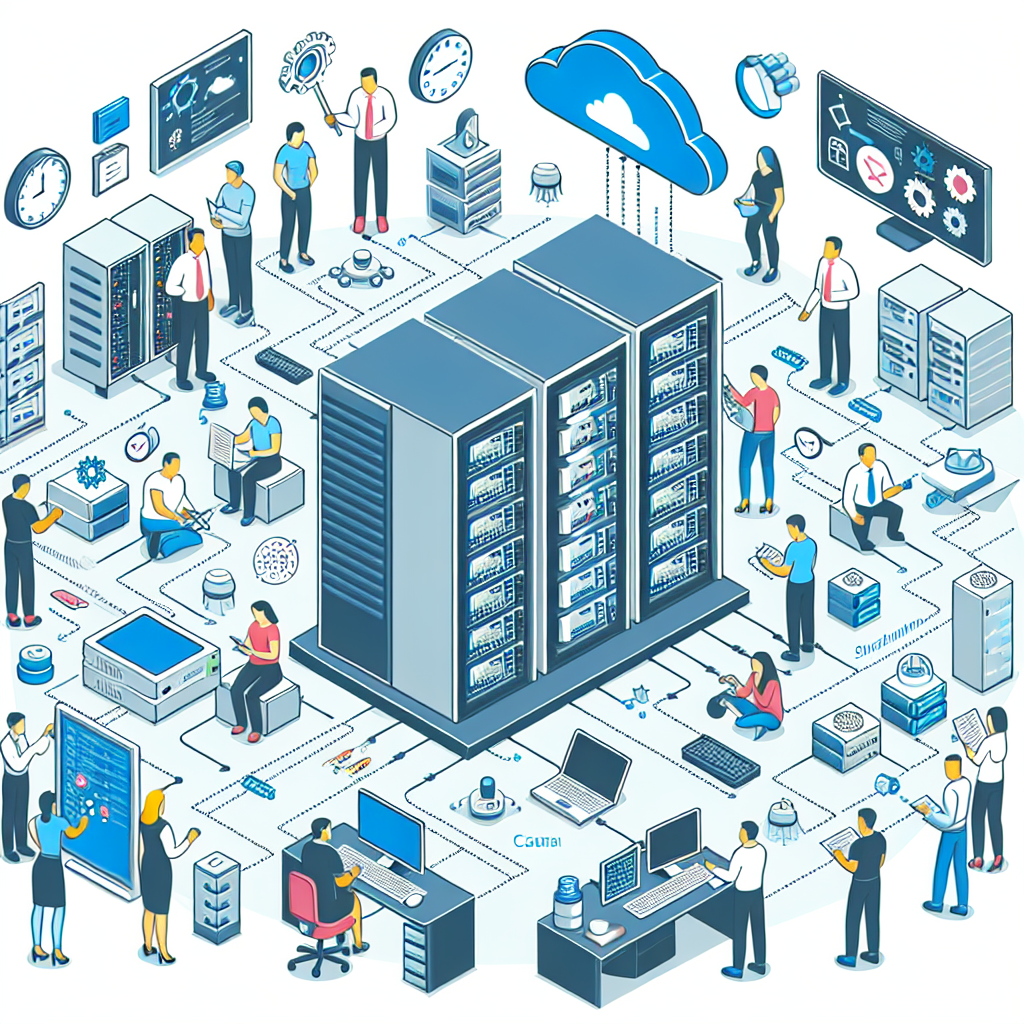Your cart is currently empty!
Tag: Steps

7 Essential Steps for a Successful Disaster Recovery Strategy
Disasters can strike at any time, and having a solid disaster recovery strategy in place is essential for ensuring the survival of your business. From natural disasters like hurricanes and earthquakes to cyber attacks and data breaches, there are countless threats that could potentially disrupt your operations. By taking proactive steps to prepare for these scenarios, you can minimize downtime and ensure that your business can quickly recover and resume normal operations. Here are seven essential steps for a successful disaster recovery strategy:1. Identify potential risks: The first step in creating a disaster recovery strategy is to assess the potential risks that your business faces. Consider both natural disasters and man-made threats, such as cyber attacks or equipment failures. By understanding the specific risks that your business is exposed to, you can develop a targeted plan to address them.
2. Develop a comprehensive plan: Once you have identified the potential risks, it’s important to create a comprehensive disaster recovery plan. This plan should outline the steps that need to be taken to protect your business in the event of a disaster, including backup procedures, communication protocols, and recovery strategies.
3. Back up your data: One of the most important aspects of a disaster recovery strategy is backing up your data. Regularly backing up your data to an offsite location ensures that you can quickly recover important information in the event of a disaster. Consider using cloud storage or other remote backup solutions to protect your data.
4. Test your plan: It’s not enough to simply have a disaster recovery plan in place – you also need to regularly test it to ensure that it will be effective in a real-world scenario. Conducting regular drills and simulations can help you identify any weaknesses in your plan and make necessary adjustments.
5. Train your staff: Your employees are a crucial part of your disaster recovery strategy, so it’s important to ensure that they are well-trained on their roles and responsibilities in the event of a disaster. Provide training on emergency procedures, communication protocols, and other key aspects of your disaster recovery plan.
6. Communicate with stakeholders: In the event of a disaster, clear communication is essential for ensuring that everyone is on the same page and that critical information is shared in a timely manner. Develop a communication plan that outlines how you will keep stakeholders informed before, during, and after a disaster.
7. Review and update your plan regularly: Finally, it’s important to regularly review and update your disaster recovery plan to ensure that it remains relevant and effective. As your business evolves and new threats emerge, your plan should be adjusted accordingly to address these changes.
By following these seven essential steps, you can create a successful disaster recovery strategy that will help protect your business in the event of a disaster. With careful planning and preparation, you can minimize the impact of a disaster and ensure that your business can quickly recover and resume normal operations.

Key Steps to Implementing a Successful Proactive Maintenance Program
Implementing a successful proactive maintenance program is crucial for businesses looking to maximize efficiency, reduce downtime, and extend the lifespan of their equipment. By taking a proactive approach to maintenance, businesses can identify and address potential issues before they escalate into costly repairs or equipment failures. To help businesses get started on the path to implementing a successful proactive maintenance program, here are some key steps to follow:1. Assess current maintenance practices: Before implementing a proactive maintenance program, it’s important to assess the current maintenance practices in place. This includes evaluating the frequency of maintenance tasks, the effectiveness of preventative maintenance measures, and the overall condition of equipment. By understanding where improvements can be made, businesses can develop a more targeted and effective proactive maintenance strategy.
2. Develop a maintenance plan: Once current maintenance practices have been assessed, businesses can develop a comprehensive maintenance plan that outlines the specific tasks, schedules, and responsibilities associated with proactive maintenance. This plan should include regular inspections, routine maintenance tasks, and scheduled downtime for equipment servicing. By having a clear plan in place, businesses can ensure that maintenance tasks are consistently performed and that equipment remains in optimal condition.
3. Invest in the right tools and technology: Implementing a successful proactive maintenance program often requires the use of advanced tools and technology to monitor equipment performance, track maintenance schedules, and identify potential issues. Investing in tools such as predictive maintenance software, remote monitoring systems, and equipment sensors can help businesses streamline their maintenance processes and improve the accuracy of their maintenance efforts.
4. Train and educate maintenance staff: A proactive maintenance program is only as effective as the people responsible for implementing it. Businesses should invest in training and educating maintenance staff on the importance of proactive maintenance, as well as how to effectively carry out maintenance tasks. By ensuring that maintenance staff are knowledgeable and skilled in proactive maintenance practices, businesses can maximize the benefits of their maintenance program.
5. Monitor and evaluate performance: Once a proactive maintenance program has been implemented, it’s important to continuously monitor and evaluate its performance. This includes tracking key performance indicators such as equipment uptime, maintenance costs, and equipment lifespan. By regularly assessing the effectiveness of the maintenance program, businesses can identify areas for improvement and make adjustments as needed to ensure optimal performance.
In conclusion, implementing a successful proactive maintenance program requires careful planning, investment in the right tools and technology, and ongoing monitoring and evaluation. By following these key steps, businesses can maximize the efficiency and reliability of their equipment, reduce downtime, and ultimately increase their bottom line.

10 Essential Steps for Data Center Disaster Recovery Planning
Data centers play a crucial role in storing and processing massive amounts of data for businesses of all sizes. However, disasters such as natural calamities, cyber-attacks, or equipment failures can disrupt data center operations, leading to data loss, downtime, and significant financial losses. Therefore, it is essential for organizations to have a comprehensive disaster recovery plan in place to ensure business continuity in the event of a disaster. Here are 10 essential steps for data center disaster recovery planning:1. Identify critical systems and data: The first step in disaster recovery planning is to identify the most critical systems and data that need to be recovered in the event of a disaster. This includes customer data, financial records, and other important information that is vital for business operations.
2. Conduct a risk assessment: Assess the potential risks that could impact your data center, such as natural disasters, cyber-attacks, power outages, or hardware failures. Understanding these risks will help you develop a more effective disaster recovery plan.
3. Define recovery objectives: Establish recovery time objectives (RTO) and recovery point objectives (RPO) for each critical system and data set. RTO refers to the maximum acceptable downtime for a system, while RPO refers to the maximum amount of data that can be lost without causing significant harm to the business.
4. Develop a disaster recovery team: Assemble a team of key personnel who will be responsible for implementing the disaster recovery plan in the event of a disaster. Designate specific roles and responsibilities for each team member to ensure a coordinated response.
5. Create a detailed recovery plan: Develop a detailed disaster recovery plan that outlines the steps to be taken in the event of a disaster. This plan should include procedures for data backup and restoration, system recovery, communication protocols, and testing procedures.
6. Implement data backup and recovery solutions: Implement robust data backup and recovery solutions to ensure that critical data is regularly backed up and can be quickly restored in the event of a disaster. Consider using cloud-based backup solutions for added redundancy and security.
7. Test the disaster recovery plan: Regularly test the disaster recovery plan to ensure that it is effective and can be successfully implemented in the event of a disaster. Conduct simulated disaster scenarios to identify any weaknesses or gaps in the plan and make necessary adjustments.
8. Train employees: Provide training to employees on the disaster recovery plan and their roles and responsibilities in the event of a disaster. Ensure that all employees are familiar with the plan and know how to respond effectively in a crisis.
9. Monitor and update the plan: Regularly monitor and update the disaster recovery plan to reflect changes in technology, business operations, or potential risks. Review the plan annually and make any necessary adjustments to ensure its effectiveness.
10. Establish communication protocols: Establish communication protocols to ensure that key stakeholders, employees, and customers are kept informed during a disaster. Develop a communication plan that includes contact information, emergency notification procedures, and regular updates on recovery efforts.
In conclusion, data center disaster recovery planning is essential for ensuring business continuity and protecting critical data in the event of a disaster. By following these 10 essential steps, organizations can develop a comprehensive and effective disaster recovery plan that will minimize downtime, data loss, and financial impact in the face of adversity.

Steps to Improve Data Center Incident Management and Minimize Downtime
Data centers are the backbone of modern businesses, storing and processing vast amounts of information critical to their operations. However, with the increasing complexity of data center infrastructure, incidents are bound to happen. These incidents can lead to downtime, which can have severe consequences for businesses, including financial losses and damage to their reputation. To prevent or minimize downtime, it is essential for data center managers to have a robust incident management plan in place. Here are some steps to improve data center incident management and minimize downtime:1. Develop a comprehensive incident response plan: The first step in improving data center incident management is to develop a comprehensive incident response plan. This plan should outline the roles and responsibilities of each team member, the procedures to follow in the event of an incident, and the steps to take to resolve the issue as quickly as possible. It should also include a communication plan to keep all stakeholders informed throughout the incident.
2. Conduct regular incident response drills: Just like fire drills are conducted to prepare employees for emergencies, data center managers should conduct regular incident response drills to ensure that all team members are familiar with their roles and responsibilities during an incident. These drills can help identify any gaps in the incident response plan and allow for improvements to be made before a real incident occurs.
3. Implement monitoring and alerting systems: Monitoring and alerting systems can help data center managers detect potential issues before they escalate into full-blown incidents. These systems can alert team members to anomalies in the data center environment, such as temperature fluctuations or power outages, allowing them to take proactive measures to prevent downtime.
4. Automate incident response processes: Automation can help data center managers respond to incidents more quickly and efficiently. By automating routine tasks, such as system reboots or failover procedures, team members can focus on more critical tasks during an incident. Automation can also help reduce human error, which can prolong downtime.
5. Conduct post-incident reviews: After an incident has been resolved, it is essential to conduct a post-incident review to identify what went wrong and how to prevent similar incidents in the future. This review should include all team members involved in the incident response, as well as key stakeholders, to ensure that lessons learned are implemented in the incident response plan.
By following these steps, data center managers can improve their incident management processes and minimize downtime, ultimately ensuring the smooth operation of their data center and the continuity of their business operations.

10 Steps to Creating a Robust Business Continuity Strategy
In today’s fast-paced and unpredictable business environment, having a robust business continuity strategy is essential for any organization. A business continuity strategy is a plan that outlines how a company will continue operating during and after a disruption or disaster. By creating and implementing a solid business continuity strategy, companies can minimize the impact of disruptions and ensure that they can continue to serve their customers and meet their obligations.Here are 10 steps to creating a robust business continuity strategy:
1. Identify potential risks: The first step in creating a business continuity strategy is to identify the potential risks that could disrupt your business operations. These risks could include natural disasters, cyber attacks, pandemics, or other unforeseen events.
2. Conduct a business impact analysis: Once you have identified the potential risks, it is important to conduct a business impact analysis to determine how these risks could affect your business operations. This analysis will help you prioritize your response efforts and allocate resources effectively.
3. Develop a business continuity plan: Based on the results of the business impact analysis, develop a comprehensive business continuity plan that outlines the steps your company will take to continue operating during a disruption. This plan should include detailed procedures for responding to different types of disruptions.
4. Establish a crisis management team: Create a crisis management team that will be responsible for implementing the business continuity plan during a disruption. This team should include representatives from key departments within your organization.
5. Test the plan: Regularly test your business continuity plan to ensure that it will be effective in a real-life situation. Conduct tabletop exercises and simulations to identify any weaknesses and make improvements to the plan.
6. Train employees: Ensure that all employees are trained on their roles and responsibilities during a disruption. Provide regular training sessions to keep employees informed and prepared.
7. Establish communication protocols: Develop communication protocols that will allow you to quickly and effectively communicate with employees, customers, suppliers, and other stakeholders during a disruption. Consider using multiple communication channels to reach everyone efficiently.
8. Backup data and systems: Implement robust data backup and recovery systems to ensure that your company’s critical information is protected and can be quickly restored in the event of a disruption.
9. Review and update the plan regularly: Regularly review and update your business continuity plan to reflect changes in your business operations, technology, and external environment. Make sure that the plan remains relevant and effective.
10. Collaborate with partners and suppliers: Work closely with your partners and suppliers to ensure that they also have robust business continuity plans in place. Establish clear lines of communication and coordination to minimize disruptions in your supply chain.
By following these 10 steps, you can create a strong and effective business continuity strategy that will help your organization weather any disruption and emerge stronger on the other side. Investing time and resources in developing a robust business continuity strategy is crucial for the long-term success and resilience of your company.

5 Essential Steps to Developing a Strong Business Continuity Strategy
In today’s fast-paced and unpredictable business environment, having a strong business continuity strategy is essential for the success and sustainability of any organization. A well-thought-out plan can help businesses navigate through unexpected disruptions, such as natural disasters, cyber attacks, or pandemics, and ensure that they can continue operating and serving their customers effectively.Here are five essential steps to developing a strong business continuity strategy:
1. Conduct a thorough risk assessment: The first step in developing a business continuity strategy is to conduct a comprehensive risk assessment. This involves identifying potential threats and vulnerabilities that could impact your business operations, such as power outages, data breaches, or supply chain disruptions. By understanding the risks that your organization faces, you can develop a plan that addresses these specific challenges.
2. Define critical business functions: Once you have identified the risks that your organization faces, the next step is to define the critical business functions that are essential for the continued operation of your business. This could include key processes, systems, and resources that are necessary for delivering products or services to customers. By prioritizing these functions, you can focus your efforts on ensuring that they are protected and can be quickly restored in the event of a disruption.
3. Develop a business continuity plan: With a clear understanding of your organization’s risks and critical functions, it is important to develop a detailed business continuity plan that outlines how your business will respond to and recover from disruptions. This plan should include strategies for mitigating risks, as well as procedures for responding to emergencies, communicating with stakeholders, and restoring operations in a timely manner.
4. Test and update the plan regularly: A business continuity plan is only effective if it is regularly tested and updated to reflect changes in your organization’s operations or external environment. Regularly conducting drills and exercises can help identify any gaps or weaknesses in your plan and ensure that your team is prepared to respond effectively to a real-life crisis. Additionally, it is important to review and update the plan annually to ensure that it remains relevant and aligned with your organization’s goals and objectives.
5. Train employees and stakeholders: Finally, it is essential to train employees and stakeholders on the business continuity plan and their roles and responsibilities in the event of a disruption. By providing training and awareness programs, you can ensure that everyone in your organization understands how to respond to emergencies and contribute to the successful implementation of the plan. Additionally, it is important to communicate regularly with key stakeholders, such as customers, suppliers, and partners, to ensure that they are aware of your business continuity strategy and can support your efforts in times of crisis.
In conclusion, developing a strong business continuity strategy is essential for protecting your organization from unexpected disruptions and ensuring that you can continue operating and serving your customers effectively. By following these five essential steps, you can create a plan that is tailored to your organization’s specific needs and helps you navigate through challenges with resilience and confidence.

How to Develop an Effective Data Center Maintenance Plan: Key Steps and Considerations
In today’s digital age, data centers are the backbone of businesses, housing valuable information and critical infrastructure. To ensure the smooth operation of a data center, it is essential to have an effective maintenance plan in place. This plan should include regular inspections, maintenance tasks, and monitoring to prevent downtime and costly repairs.Here are some key steps and considerations to help you develop an effective data center maintenance plan:
1. Conduct a thorough assessment: Before creating a maintenance plan, it is important to conduct a thorough assessment of your data center’s current state. This should include a review of the equipment, systems, and infrastructure to identify any potential issues or areas that need attention.
2. Define maintenance tasks: Once you have identified the areas that need attention, it is important to define the maintenance tasks that need to be performed. This can include tasks such as cleaning, testing, and replacing equipment as needed.
3. Establish a schedule: Establishing a regular maintenance schedule is crucial to ensure that tasks are completed in a timely manner. This schedule should include daily, weekly, monthly, and annual tasks to keep your data center running smoothly.
4. Implement monitoring tools: Monitoring tools can help you keep track of the performance of your data center equipment and systems. These tools can provide real-time data on temperature, humidity, power usage, and more, allowing you to identify and address issues before they become major problems.
5. Train your staff: Proper training is essential for the successful implementation of a data center maintenance plan. Make sure your staff is trained on how to perform maintenance tasks, use monitoring tools, and respond to emergencies.
6. Document everything: It is important to document all maintenance tasks, inspections, and repairs to keep track of the status of your data center. This documentation can also help you identify trends and patterns that may indicate the need for additional maintenance or upgrades.
7. Regularly review and update the plan: A data center maintenance plan should not be static. It is important to regularly review and update the plan to ensure that it is still effective and meets the needs of your data center.
By following these key steps and considerations, you can develop an effective data center maintenance plan that will help you keep your data center running smoothly and avoid costly downtime. Remember, prevention is always better than cure when it comes to maintaining your data center.

Going Green: Steps Companies Can Take to Make Data Centers More Sustainable
In today’s world, the push for sustainability and environmental consciousness is more important than ever. Companies are increasingly recognizing the need to reduce their carbon footprint and adopt eco-friendly practices in all aspects of their operations, including data centers. Data centers are crucial for businesses to store and process vast amounts of information, but they also consume a significant amount of energy and resources. However, there are steps that companies can take to make their data centers more sustainable and environmentally friendly.One of the first steps companies can take to make their data centers more sustainable is to optimize their energy usage. This can be done by implementing energy-efficient technologies, such as virtualization and consolidation, which allow companies to use their servers more efficiently and reduce energy consumption. Companies can also consider using renewable energy sources, such as solar or wind power, to power their data centers. By minimizing energy usage and switching to renewable sources, companies can significantly reduce their carbon footprint and lessen their impact on the environment.
Another important aspect of making data centers more sustainable is reducing water usage. Data centers require large amounts of water for cooling purposes, but there are ways to minimize water consumption. Companies can implement water-efficient cooling systems, such as air-side economizers or liquid cooling systems, which can significantly reduce water usage. Additionally, companies can implement water recycling systems to reuse water for cooling purposes, further reducing their water consumption and environmental impact.
In addition to optimizing energy and water usage, companies can also focus on reducing waste in their data centers. This can be done by implementing recycling programs for e-waste and other materials, as well as using sustainable materials for construction and equipment. Companies can also consider donating or repurposing old equipment rather than disposing of it, further reducing waste and promoting sustainability.
Furthermore, companies can also consider implementing green building practices in their data centers. This can include using energy-efficient lighting, installing energy-efficient HVAC systems, and using sustainable building materials. By adopting green building practices, companies can reduce their energy usage and environmental impact, while also creating a healthier and more sustainable work environment for their employees.
Overall, there are many steps that companies can take to make their data centers more sustainable and environmentally friendly. By optimizing energy and water usage, reducing waste, and implementing green building practices, companies can significantly reduce their carbon footprint and contribute to a more sustainable future. Going green is not only good for the environment, but it can also benefit companies by reducing costs, improving efficiency, and enhancing their corporate social responsibility. By taking steps to make their data centers more sustainable, companies can lead the way in promoting environmental consciousness and creating a more sustainable world for future generations.

How To Visualize Like A World Champion: Manifest Your Dreams With Creative Visualization In 6 Steps
Price: $3.99
(as of Nov 21,2024 15:31:37 UTC – Details)From the Publisher










The Mental Process Of Visualization
The subconscious mind is a powerhouse of untapped potential. It operates beyond our conscious awareness, influencing our thoughts, emotions, and actions. In the book you will discover the mental process of visualization so that it will become natural, thus speeding up your manifestation.
How To Begin A Visualization
When is the best time to visualize? How do you visualize? What if I’m faced with negativity or a negative self image? In the book we’ll answer all these questions and more as you discover how to properly remove negativity, how to properly set up your atmosphere and the best time to visualize.
The ONE Word You Should Never Use
What is the ONE word you should not use during or after your visualization?
In the book you will discover that one word how to create new neural pathways that support the manifestation of your goals. This means that through regular visualization, you’re literally rewiring your brain to think and act in ways that are conducive to your success.


ASIN : B07633Y9V9
Publisher : The Affirmation Network Publication (September 30, 2017)
Publication date : September 30, 2017
Language : English
File size : 455 KB
Text-to-Speech : Enabled
Screen Reader : Supported
Enhanced typesetting : Enabled
X-Ray : Enabled
Word Wise : Enabled
Print length : 134 pages
Page numbers source ISBN : 1977914454Customers say
Customers find the language concise, clear, and easy to understand. They describe the book as inspiring, motivating, and insightful. Readers also mention it’s a great read that combines useful techniques with deep religious insights.
AI-generated from the text of customer reviews
Have you ever wondered how some of the world’s most successful athletes, entrepreneurs, and artists achieve their dreams? The answer lies in the power of creative visualization. By harnessing the incredible power of your imagination, you can manifest your deepest desires and achieve success beyond your wildest dreams.Here are 6 steps to help you visualize like a world champion and manifest your dreams:
1. Set clear and specific goals: Before you can begin visualizing your dreams, you need to have a clear idea of what you want to achieve. Write down your goals in detail, including specific milestones and deadlines.
2. Create a vision board: A vision board is a powerful tool for visualizing your goals and dreams. Gather images, quotes, and other visual representations of your goals and create a collage that you can look at every day to keep yourself motivated.
3. Practice daily visualization: Spend at least 10-15 minutes each day visualizing your goals as if they have already been achieved. Use all of your senses to make the experience as vivid and real as possible.
4. Stay positive and focused: It’s important to maintain a positive attitude and stay focused on your goals, even when faced with challenges and setbacks. Trust in the power of your visualization practice to help you overcome obstacles and achieve success.
5. Take inspired action: Visualization is a powerful tool, but it’s important to also take action towards your goals. Use your visualization practice to inspire and motivate you to take the necessary steps to make your dreams a reality.
6. Believe in yourself: The most important step in manifesting your dreams is to believe in yourself and your ability to achieve success. Trust in the power of your visualization practice and have faith that you are capable of achieving anything you set your mind to.
By following these 6 steps and dedicating yourself to a daily visualization practice, you can harness the incredible power of your imagination to manifest your dreams and achieve success like a world champion. So what are you waiting for? Start visualizing your dreams today and watch as your life transforms before your eyes.
#Visualize #World #Champion #Manifest #Dreams #Creative #Visualization #Steps
The Key Steps to Conducting a Successful Data Center Risk Assessment
A data center risk assessment is a crucial step in ensuring the security and reliability of your organization’s IT infrastructure. By identifying potential threats and vulnerabilities, you can take proactive measures to mitigate risks and prevent costly downtime or data breaches. In this article, we will discuss the key steps to conducting a successful data center risk assessment.1. Identify Assets: The first step in conducting a data center risk assessment is to identify all the assets within your data center. This includes hardware, software, data, and other resources that are critical to your organization’s operations. By creating an inventory of assets, you can better understand what needs to be protected and prioritize your risk management efforts.
2. Assess Threats and Vulnerabilities: Once you have identified your assets, the next step is to assess the potential threats and vulnerabilities that could impact them. This may include natural disasters, cyber attacks, equipment failures, or human error. By conducting a thorough analysis of potential risks, you can develop a comprehensive risk management plan to address them.
3. Evaluate Controls: After identifying threats and vulnerabilities, it is important to evaluate the effectiveness of existing controls in place to mitigate these risks. This may include firewalls, encryption, access controls, and disaster recovery plans. By assessing the strengths and weaknesses of your current controls, you can identify gaps and prioritize areas for improvement.
4. Determine Risk Levels: Once you have assessed threats, vulnerabilities, and controls, the next step is to determine the level of risk posed to your data center. This involves assigning a risk level to each potential threat based on its likelihood and impact on your organization. By prioritizing risks based on their level of severity, you can focus your resources on addressing the most critical threats first.
5. Develop a Risk Management Plan: Based on the results of your risk assessment, it is important to develop a comprehensive risk management plan to address identified threats and vulnerabilities. This plan should outline specific actions to be taken to mitigate risks, assign responsibilities to key stakeholders, and establish a timeline for implementation. By creating a structured plan, you can ensure that risk management efforts are coordinated and effective.
6. Monitor and Review: Finally, conducting a successful data center risk assessment is an ongoing process. It is important to regularly monitor and review your risk management plan to ensure that it remains effective in addressing evolving threats and vulnerabilities. By staying proactive and responsive to changing risks, you can protect your organization’s data center and maintain business continuity.
In conclusion, conducting a successful data center risk assessment is essential for ensuring the security and reliability of your organization’s IT infrastructure. By following these key steps, you can identify potential threats, evaluate controls, determine risk levels, develop a risk management plan, and monitor and review your efforts to protect your data center from harm. By prioritizing risk management and staying proactive, you can safeguard your organization’s critical assets and maintain operational continuity in the face of potential threats.

